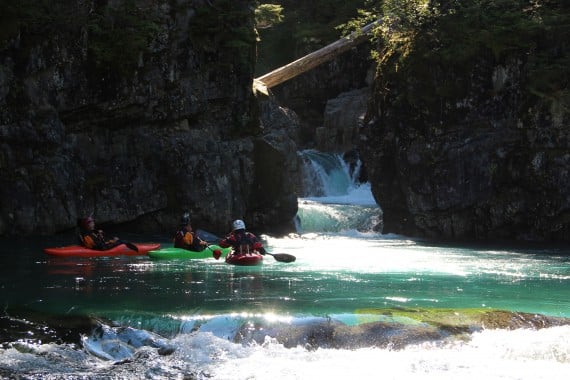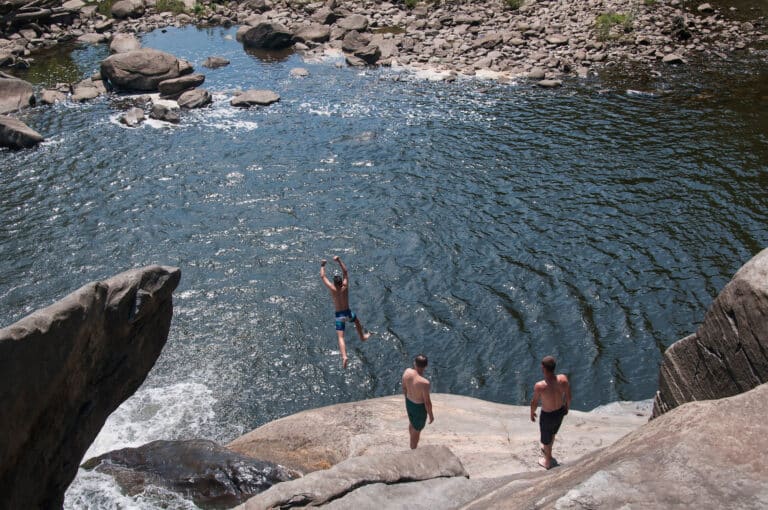So you have been whitewater rafting with your friends, and want more of a challenge… you want to jump in one of those crazy little plastic kayak things!
I can’t blame you at all. Kayaks represent an autonomy that few sports can match. It’s just you, your boat, and the water. Rivers represent a simple and beautiful mode of transportation that allows you to see places on our planet that are not accessible through any other means.
There are a couple of things that are important to think about as you get into the sport. Here are my words of advice:
1) Learn from someone who knows what they are talking about.
There are a variety of excellent kayak instruction outfits across the Blue Ridge Mountains. Check out the Nantahala Outdoor Center and the US National Whitewater Center in North Carolina, ACE Adventures in West Virginia, and Liquid Adventures near Washington D.C. Good instruction is irreplaceable for your paddling progression and your safety on the river. That initial foundation of skills cannot be stressed enough.
2) Buy used initially to see what you like, and then spend the big bucks for the right gear once you’re educated on the sport.
While it’s nice to jump in and have superfly gear, it may be helpful to get a “starter” boat and gear, and dial in exactly what it is that interests you in the sport. Kayaking has a myriad genres – slalom, extreme, playboating, squirt boating, river running… and each one is appealing to different folks. Once you figure out exactly what you want, spend the extra money and get the gear that specializes in that. Expect to pay around $600 for the initial used gear, and maybe close to $2000 for the nicest new setup. I’m a bit biased, but definitely take a good look at the Dagger line of boats 😉
Once you’ve bought that equipment, you’re set! No lift tickets in this sport; just drive to the river and put on.
3) Practice your rolls and handrolls!
The eskimo roll is the single most important skill for the beginning kayaker. Until you have that dialed, you will be swimming out of your boat every time you flip, and your gear will go everywhere in what we refer to as the “yardsale.” Learn the correct technique for rolling your boat upright with or without your paddle, and then practice, practice, practice. You want this to become second nature. Once you have it, the sky is the limit!
4) Join a local paddling community.
There are many excellent clubs throughout the Southeast to network and meet other paddlers. These clubs host presentation nights, video premieres, and group trips. This is the next step after the initial instruction phase. Once you are paddling confidently in these clubs, you may also split off and paddle with a couple of individuals who are at the same skill level and have the same goals as you. Don’t forget to pay it forward once you are at that level. The experts giving up their knowledge to beginners is what makes clubs such a valuable thing. If you are a college student, you have a leg up on this – many Southeastern schools have excellent paddling programs.
5) Run a slow progression of difficulty in rivers as you improve.
Check out the current Blue Ridge Outdoors issue for a list of the best rivers of the Southeast. There is something for everyone’s taste in there, and you will surely develop your own favorites based on where you live and your appetite for adventure. The most important thing is to take it slow, and not rush your progression. Whitewater is a very unforgiving medium, and if you try to push it too far too fast, bad things can happen. Focus on making difficult moves in easy whitewater, and then moving up slowly. American Whitewater and the excellent guidebooks by Brushy Mountain Publishing can be great resources for dialing in which rivers you will want to run.
I hope that is helpful to you beginner and intermediate paddlers! It truly is an incredible sport, and please don’t blame me if it becomes a crippling addiction that supercedes other priorities in your life! Kayaking tends to do that.
Good lines, and see you on the river.
Chris Gragtmans








